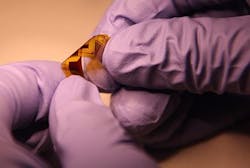Chalcogenide glass structures within polymer enable flexible photonic devices
Researchers at the University of Delaware (Newark, DE), the College of Optics and Photonics (CREOL) at the University of Central Florida, and IRradiance Glass (both in Orlando, FL) have developed a way to fabricate high-performance, high-index-contrast flexible optical devices that combine chalcogenide glass with polymers.1 Chalcogenide glass is commonly used in infrared optics, optical fibers, camera lenses, and prisms. While the material is not flexible, it is fully compatible with flexible polymers, which allows it to be processed and made into devices.
Using this technique, the researchers have created photonic devices such as waveguides, microdisk resonators, add–drop filters, and photonic crystals.
Glass is placed near the polymer's neutral axis
The researchers exploited the fact that polymers naturally tend to deform (or bend) in certain ways, with some areas remaining strain-free all the time (areas near the mechanical "neutral axis"); by selectively placing the chalcogenide glass photonic device near the neutral axis, they are able to achieve a device with superior flexibility and high optical performance.
"The beauty of this technology is that the chalcogenide glass works with almost any type of polymer, allowing it to be used in many ways," explains Juejun Hu, assistant professor of materials science and engineering at the University of Delaware and lead researcher on the project.
In laboratory testing, Hu's device functioned well even when bent to a radius of 0.5 mm more than 5000 times. The device has one of the lowest optical losses for flexible optical devices on record, almost an order of magnitude less than previous devices. Applications for the work include wearable devices, flexible consumer electronics, foldable portable power-generation systems, and sensors that can be integrated on human skin. It also opens the door for photonics to be used in biomedical applications such as flexible electrodes to measure the electrical activity of the brain during an electroencephalogram (EEG).
Source: http://www.udel.edu/udaily/2015/aug/optical-devices-080414.html
REFERENCE:
1. Lan Li et al., Nature Photonics (2014); doi: 10.1038/nphoton.2014.138

John Wallace | Senior Technical Editor (1998-2022)
John Wallace was with Laser Focus World for nearly 25 years, retiring in late June 2022. He obtained a bachelor's degree in mechanical engineering and physics at Rutgers University and a master's in optical engineering at the University of Rochester. Before becoming an editor, John worked as an engineer at RCA, Exxon, Eastman Kodak, and GCA Corporation.
